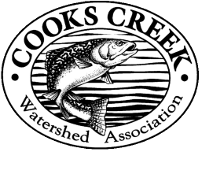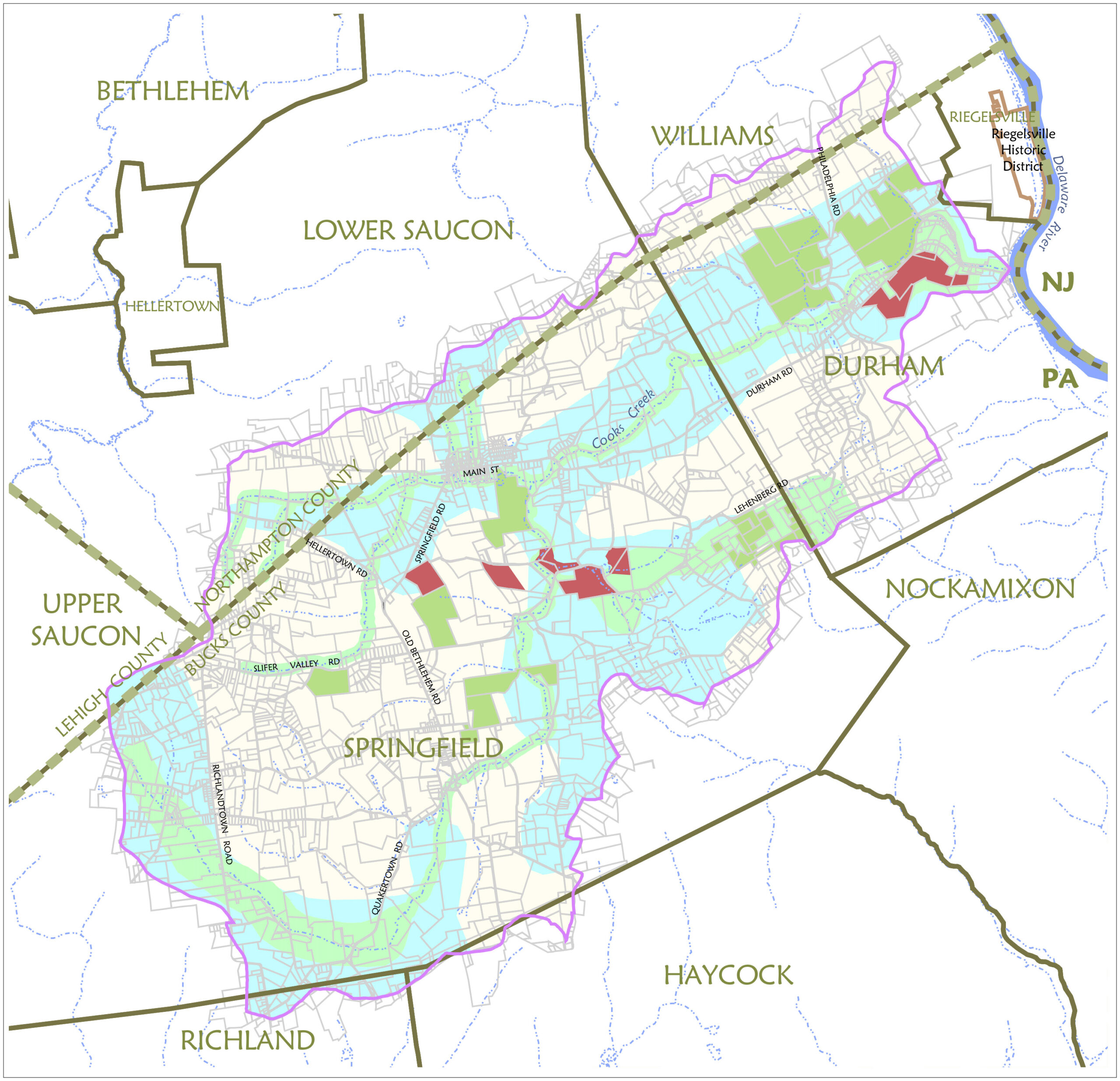Location and Size
Cooks Creek Watershed is a 30-square-mile limestone valley watershed in northern Bucks County, Pennsylvania. The main stem of Cooks Creek flows in an easterly direction into the Delaware River. The watershed area consists of a number of small, mostly unnamed tributaries with approximately 24 square miles in Springfield Township and 5.5 square miles in Durham Township. Some headwater tributaries are located in Lower Saucon Township, Northampton County. Small areas of the watershed are also found in Upper Saucon and Williams Townships in Northampton County and Haycock and Richland Townships in Bucks County.
Characteristics of the Watershed
The Cooks Creek Watershed has been designated as an Exceptional Value Cold Water Fishery under the Pennsylvania Chapter 93 Water Quality Standards and is the only wild brown trout and native brook trout fishery in Bucks County. Cooks Creek Watershed is home to numerous rare and endangered species, including several rare reptiles and amphibians. The Cooks Creek Watershed was rated Priority 1 in the 1999 Bucks County Natural Areas Inventory, is part of Heritage Conservancy’s Lasting Landscapes® program, and has been designated as an area of special concern by the Highlands Coalition. Several recent studies conducted by the Durham Township Environmental Advisory Council (DTEAC) have indicated that the biological communities within Cooks Creek Watershed are sensitive to changes in water quality and quantity. The underlying geology is mostly limestone, and contains a high quality drinking water aquifer that is the sole source of drinking water for the majority of the residents.
Land use in the watershed is mostly agricultural and rural residential although the scattered small village centers have some commercial zoning. The only industrial zoning is located in Durham Township at the creek’s confluence with the Delaware River. There are several small businesses that may represent a threat to water quality, although preliminary investigations have shown no measurable impacts. Water usage in the watershed is mostly residential, with a small water authority in Springfield Township that obtains its water from the springs that abound along the limestone/granite interface that surrounds the watershed.
Former uses of Cooks Creek included diversions to power grain, lumber and paper mills. While these facilities are no longer in use, the low-level dams used represent an ongoing impact for the wildlife that uses the watershed. By far the largest ongoing threat to water quality and quantity in the watershed is residential development.
Watershed Protection Plan
The fragile nature of the limestone aquifer and the increase in development pressure in surrounding townships is the main reason the DTEAC was compelled to initiate the Cooks Creek Watershed Protection Plan. The overall goal of the Cooks Creek Watershed Protection Plan and associated plans was to provide a sound database from which comprehensive plans and zoning ordinances appropriate for the watershed can be made that take into account the current quality of the watershed, the quantity of available drinking water, and its sensitivity to degradation. To view a copy of the Cooks Creek Watershed Protection Plan, click here.
The Cooks Creek Watershed Association is currently involved in regional planning efforts that will ensure the long-term protection of the creek. Members are currently active in local government in Durham, Springfield and Lower Saucon townships. Cooks Creek Watershed Association members spearheaded the effort to found Environmental Advisory Councils (EACs) in all three townships and has and/or currently holds positions as members of Planning Commissions and on the Board of Supervisors. In 2002, the Cooks Creek Watershed Protection Plan was approved by the Pennsylvania Department of Conservation and Natural Resources (PA DCNR). This award-winning plan was the culmination of over three years of study and more than 1000 hours of volunteer effort, mostly on the part of Cooks Creek Watershed Association members. In the years since, most of the work suggested by the plan has been performed including considerable work on regulation of development and stormwater in both Durham and Springfield.
Growing Greener
In 2018, CCWA obtained a grant from the State to rehabilitate our stream gauging stations and collect water quality and benthic community data to assess the health of the Watershed. These reports are now available for you to examine and learn more about the current health of the Creek. We are looking into future grant opportunities to continue exploring the issues we uncovered in this study. Look to the linked page for these updates on water quality and quantity.
Mini-Monster Mayhem
In 2002 we hosted our first children’s workshop on watersheds and water quality, called Mini-Monster Mayhem. It’s a play on words of course, but the focus is to introduce children of all ages to water and watersheds, as well as the myriad of creatures which live on, in and under the water of our Creek. We have hosted over 20 of these workshops over the years, typically with one or two dozen children in attendance. Some of these kids have gone on to school in environmental science, and some have dedicated their careers to the field having been inspired by us! This event is free and open to the public and is held on the Saturday of Father’s Day weekend every year in June.
Roadside Cleanup
In 2004 we started a community wide roadside greenup effort. Roadside cleanups not only improve the look and feel of our community, but keep trash out of our stream. Trash does not cause pollution per se, but it does impact wildlife and just looks bad. The program is part of the Adopt A Highway Program of PennDOT, who provides the bags, gloves and vests and takes away the trash. Springtown Fire Company provides the space to meet and have our famous homemade chili lunch. Springfield Township provides police for safety and helps us gather up the bags of trash. This event is held annually on the first Saturday in April.
Future Direction
We are always looking for ways to expand our educational and outreach programs. In 2022 we obtained a grant from the Penn Community Foundation to mount two educational plaques describing the Watershed and some of its important environmental and historical resources. These posters can be viewed in the community rooms at Springfield and Durham Townships as well as outside at Peppermint Park and Durham Park.
Other programs are possible, limited only by the interest of our membership. If you are interested in becoming a member, being involved with the Board of Directors, working on conservation projects, or making a donation, please click here.

